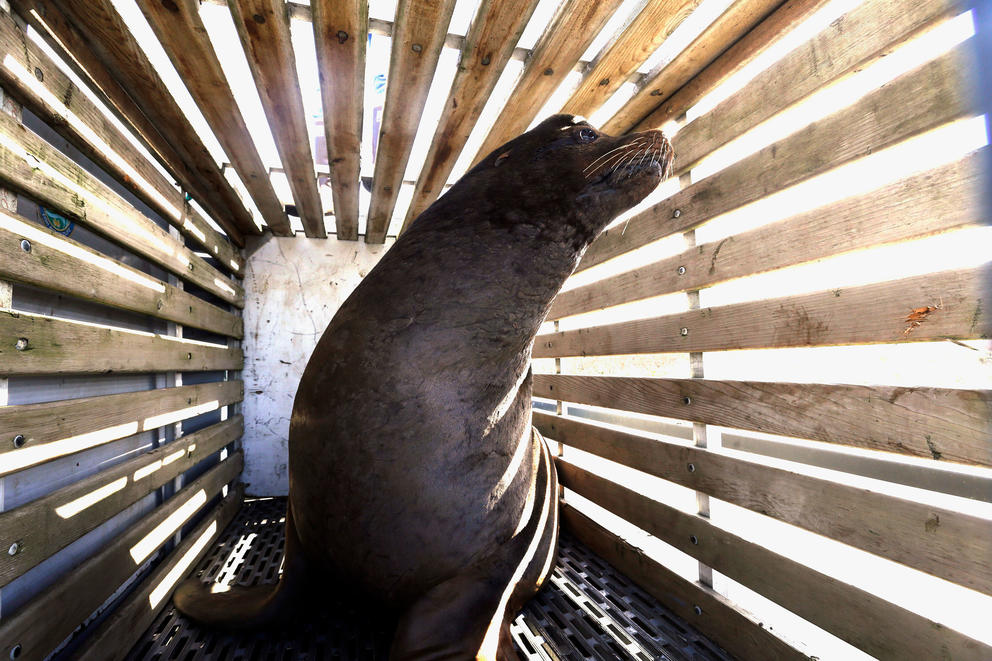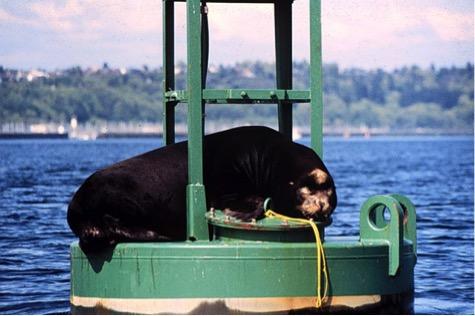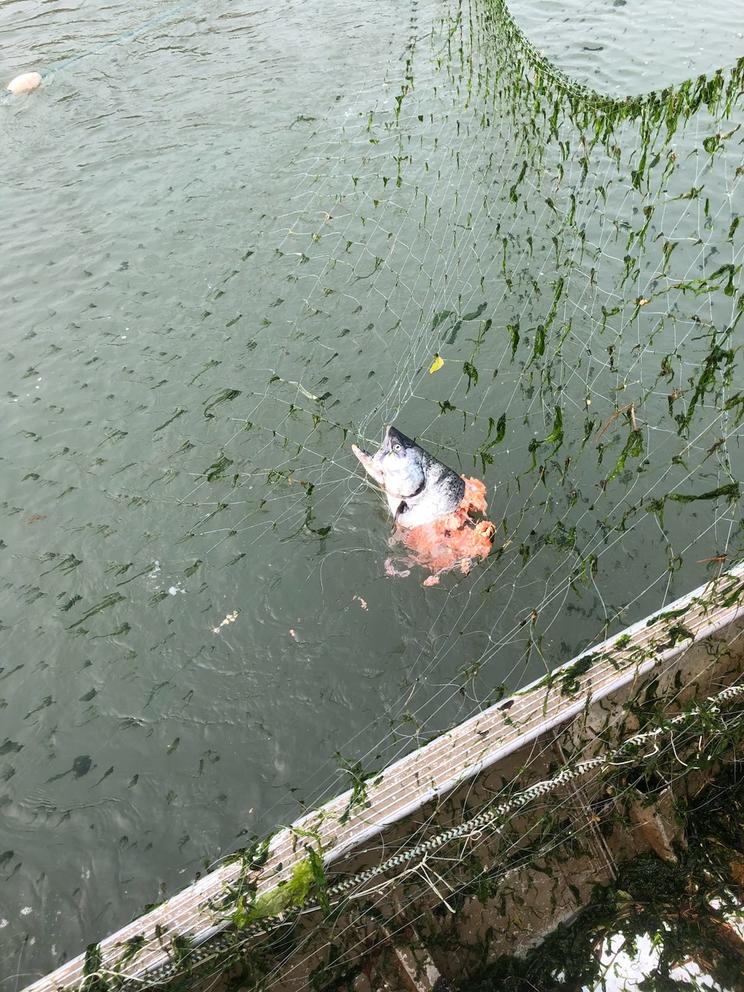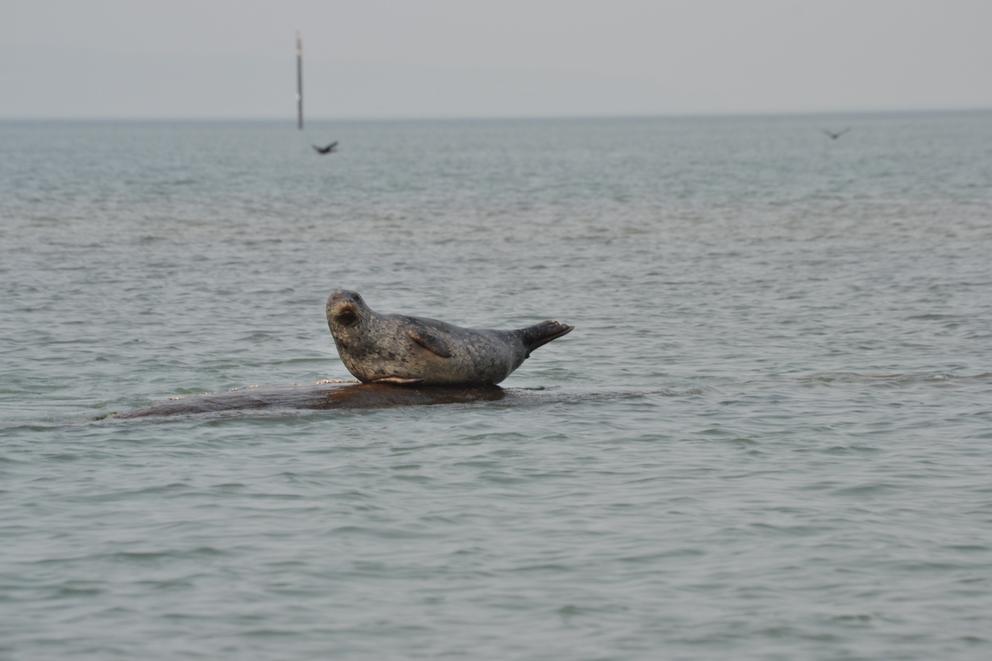The shore anglers had good reason to be annoyed. Each time they hooked a fish, this sea lion would pop up and eat it off their line.
The sea lion, nicknamed Herschel by the fishermen, quickly moved on from taking fish off lines to gobbling up steelhead as they tried to make it over the ladder south of the locks. Here, water sluices down stair-stepped pools and migrating fish jump from pool to pool until they reach the Lake Union Ship Canal and spawning grounds beyond. Herschel found that by hanging out under the fish ladder he could gorge himself on steelhead trying to make it upstream.
Over the next few years, it became apparent that Herschel and a handful of other large male sea lions were seriously depleting the winter steelhead run, putting the population that spawns in Lake Washington’s tributaries at risk of extinction.
California sea lions spend part of the year at breeding sites on the Channel Islands. The bulls that feed at the bottom of fish ladders, where salmon practically swim down their gullets, have a distinct advantage in their battles for mates and territory.
“If you were a sea lion and you wanted to bulk up, you’d eat these adult fish that are all fat and full of eggs,” said Steven Jeffries, a research scientist and marine mammal specialist for the Washington Department of Fish and Wildlife. “Their caloric content is off the charts.”
By the mid 1980s, Herschel had disappeared. The rumor was he’d been shot -- perhaps by a vengeful angler -- but his absence didn't have much impact. Over the next 10 years, more than 30 California sea lions were seen eating migrating salmon and steelhead near the locks. The largest and most voracious, a 1,200-pounder named Hondo, clocked in at 400 pounds more than what was thought at the time to be the maximum weight for his species.
The question of what to do about Hondo and his compatriots, who were protected under federal law, reverberated around Seattle, Washington State and eventually the U.S. Congress.
More than 30 years later, the debate continues over how to handle predation on endangered and threatened fish stocks by pinnipeds, a group of marine mammals that includes seals and sea lions. Now there’s more than angry fishermen to appease: Pinniped numbers have increased so much that they are getting some of the blame for the decline of resident orcas in the Pacific Northwest. In a strange situation that pits Puget Sound’s protected marine mammals against each other, some conservationists are weighing whether there are enough salmon to feed orcas and pinnipeds.
Hundreds of sea lions now congregate in the Columbia River and its tributaries, decimating salmon runs that migrate upstream into Washington and Idaho. Over the last 10 years state resource managers have killed nearly 200 animals near the Bonneville Dam in Oregon, and they’re asking for permission to lethally remove them in other parts of the river.
Meanwhile, proposals to kill off harbor seals in Puget Sound that failed to gain traction in the past are now being taken more seriously. One of three breakout sessions during the Aug. 28 meeting of Gov. Jay Inslee’s task force to save the dwindling southern resident killer whales focused exclusively on proposals to reduce salmon predation by pinnipeds, which compete for food with fish-eating orca pods. The widely reported death of a southern resident calf, and the subsequent two weeks of grieving by its mother, has increased urgency to take drastic steps to save the southern residents. Killing pinnipeds, however, remains controversial.
Harbor seals feed more often on juvenile salmon than adults, and studies have found they eat more individual fish than any other predator. Orcas consume the most salmon biomass --- they eat fewer individual salmon, but the fish they eat are older and larger. Sea lions eat less biomass than the orcas, but state resource managers say they have a particularly detrimental impact on salmon populations because they eat spawning adults at fish ladders.
Willie Frank III, a Nisqually Tribal Council member, said he’s watched pinnipeds move farther up the tribe’s namesake river in recent years. The summer chinook, fall coho and winter chum runs are all depleted, and fisheries managers have limited the number of days the Nisqually can use their gill nets. But while the salmon have decreased, harbor seals have increased. They swim up the river and eat fish right out of the nets. Sometimes Nisqually fishermen will find only salmon heads left by seals. On a recent Sunday, fishing began at noon and by 4 p.m. Frank said his family had lost 10 chinook to seals.
“The seals and sea lion that are eating salmon are affecting our fishermen that have been fishing down here their whole lives,” Frank said. “We’re rich with fishermen down here. Our elders are fishing well into their 80s.”
A number of conservation groups remain strongly opposed to killing the protected marine mammals. They point out that humans have contributed to salmon stocks’ decline and say pinnipeds shouldn’t suffer the consequences. The removal of seals and sea lions could have unintended and unexpected impacts across the ecosystem, including removing the primary food source for the mammal-eating transient killer whales.
In the 1980s, Jeffries was working with wildlife managers experimenting with underwater speakers to chase sea lions out of the mouth of the Columbia River. After learning of sea lion predation on the winter steelhead run, they moved to Ballard.
When the speakers were blasting noise at 205 decibels underwater, the sea lions swam with their heads above the surface. When wildlife managers tried to put netting across the canal below the locks, Hondo and his buddies hauled out of the water and waddled around the barrier. Wildlife managers have tried harassing sea lions with fire crackers, shooting them with rubber-tipped arrows and trapping and moving sea lions as far away as California. Nothing has worked.
“It’s a challenge trying to outsmart them,” Jeffries said.
At the time, the 1972 Marine Mammal Protection Act prevented the state from killing sea lions. Bounties offered by western states to protect fish stocks in the 20th Century drove pinniped populations dangerously low. In 1994, in response to the severe reduction of the Ballard winter steelhead run, Congress amended the law to allow the killing of problem pinnipeds. Since they’ve been protected, California sea lions have rebounded from fewer than 90,000 in the 1970s to nearly 300,000 today. Harbor seals have undergone a similar recovery, as have Steller sea lions, although those northern cousins of Herschel and Hondo are less often involved in confrontations with humans over fish.
In addition to the permit for lethal removals at the Bonneville Dam nearly 150 miles upstream from the Pacific Ocean, Oregon has asked for permission to kill sea lions below Willamette Falls. Officials say they’re ready to start trapping and killing during the November steelhead run if the federal government approves that request.
Proponents of removing sea lions say the animals are behaving unnaturally and are outside their historic ranges. There’s little historical record of sea lions traveling up the Columbia River and sparse archeological evidence as well.
But opponents say removing pinnipeds is a man-made solution to a man-made problem. Human pollution, overfishing and habitat destruction have all contributed to declining salmon stocks.
Killing sea lions is an attempt at a quick fix that avoids more difficult discussions around dam removal or reducing human catch limits, said Robb Krehbiel, the Northwest representative for Defenders of Wildlife. There’s not enough evidence that killing pinnipeds has an impact on salmon populations, Krehbiel said.
“When we start talking about heavy-handed management of ecosystems, humans often get it wrong,” he said. “The more we try to pick up guns and engineer our way out of the problem, the worse it gets.”
The process of killing pinnipeds under existing federal law is resource intensive. It involves trapping, branding or tagging an animal, releasing it and using non-lethal detterrance. When that fails, state officials try to trap the sea lion again -- under federal law they could shoot it, but that method hasn’t been used -- and euthanize it.
Bipartisan legislation from a group of lawmakers from Washington, Idaho and Oregon would make it easier for wildlife managers to kill sea lions they encounter more than 112 miles upstream on the Columbia River or one of its tributaries. A version of the bill has already passed the House and a Senate bill by Jim Risch, R-Idaho, was passed out of committee in August.
Wildlife managers can reduce predation of salmon and limit their impact on the sea lion population by removing only the animals that have learned to feed below dams in the Columbia River, said Shaun Clements, senior policy analyst for the Oregon Department of Fish and Wildlife.
“In the Columbia basin, their diet is 99 percent these salmon, steelhead and sturgeon, and essentially it’s not a natural behavior,” Clements said. “Fish didn’t evolve to have that level of predation. You’re just targeting a proportion of the (sea lion) population that’s preying exclusively on salmon, steelhead, sturgeon where they’re available. You’re still leaving 99-plus percent of the population out there.”
Removing harbor seals, which feed at the mouths of rivers and eat juvenile salmon in Puget Sound, presents a very different challenge. After the Aug. 28 meeting, members of the orcas task force said the issue needs more study. It’s not clear how much the seals’ feeding on juveniles impacts total stocks, and there might be non-lethal ways to reduce their predation. Increasing other food sources for seals, removing artificial haulouts near spawning rivers and staging the release of hatchery fish, which draw seals when they enter the sound in large numbers, could reduce predation.
Biologists are concerned that culling large numbers of pinnipeds could have a cascading effect across the ecosystem that goes beyond the transient orcas that eat seals and sea lions. Harbor seals feed on fish like Pacific hake that also eat young salmon.
“My fear is that ... others see this as a way to cull animals and remove them from the entire coast,” said Andrew Trites, the director of the Marine Mammal Research Unit at the University of British Columbia. “That concerns me a lot. I think that would be a real tragedy.”
Trites isn’t convinced that seals and sea lions are outside of their historical range today. It’s possible their populations along the West Coast had been depleted by hunting well before white settlers arrived in the area.
“We tend to assume interaction between people and seals started with the arrival of Europeans, but it’s happened for thousands of years,” Trites said. “So there would have been hunting pressure put on the animals, and this is the first time in millenia that we have a chance to go back to an equilibrium.”
But he acknowledges feeding at the dams is having an unnatural impact on salmon populations, and it won’t be easy to return the Columbia and its tributaries to their natural states. Dams in the region are a major source of hydropower and are important for agriculture.
“The trade off may be if you’re going to have dams and locks, you have just have to destroy the animal,” Trites said. “You’ll have some no-go seal and sea lion areas, and it’s the price the population will have to pay to ensure the salmon survive. So in other words, it’s not a fair game. When you put predator and prey at the base of a dam, the dice are loaded in the predator’s favor.”
He cautioned that any killings of pinnipeds need to be carefully studied to gauge their impact. The shooting of about 50 seals in 1997 and 1998 at the mouth of the Puntledge River on Vancouver Island was hailed as a success when the salmon populations increased. But what’s often overlooked is that salmon populations increased at other rivers in the region where no killings occurred, raising questions about whether the Puntledge killings had any impact, Trites said.
When the Marine Mammal Protection Act was amended in 1994, the state of Washington finally had permission to trap and kill Hondo. A movement to save him materialized, including letter writing campaigns and protests. Instead of being killed, Hondo found himself with a one-way ticket to Florida.
“We were prepared to lethally remove those animals when the SeaWorld corporation said they would accept those six animals,” Jeffries said. “So all the sea lions that were on the list were never lethally removed. We actually caught those animals and loaded them on a DC-10 and SeaWorld paid to have them Fed Exed from SeaTac to Orlando.”
But it was too late to save the winter steelhead run in Ballard. Despite Hondo’s removal, the steelhead population was all but wiped out.
“It dropped below 50 fish, and then once it dropped below 50 fish, the sea lions went away,” Jeffries said. “The lesson we learned from Ballard is if you don’t do anything about seal and sea lion predation, they’ll eat (salmon runs) down to nothing.”






